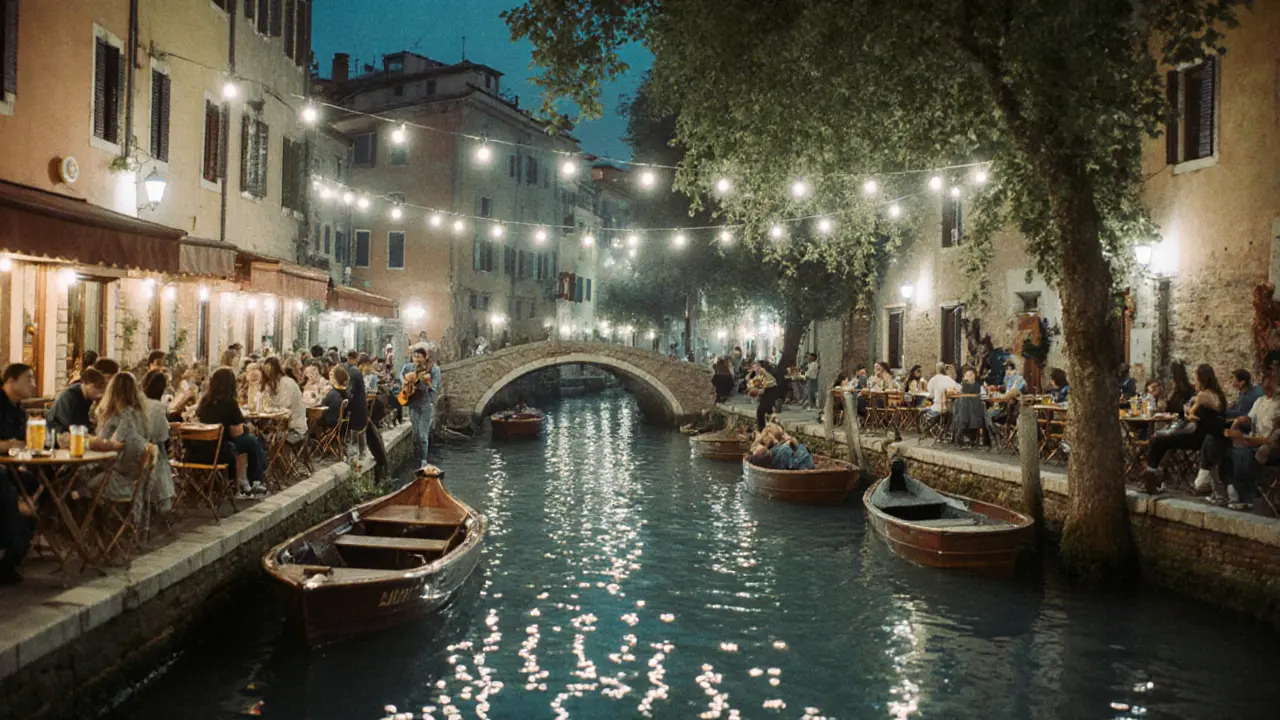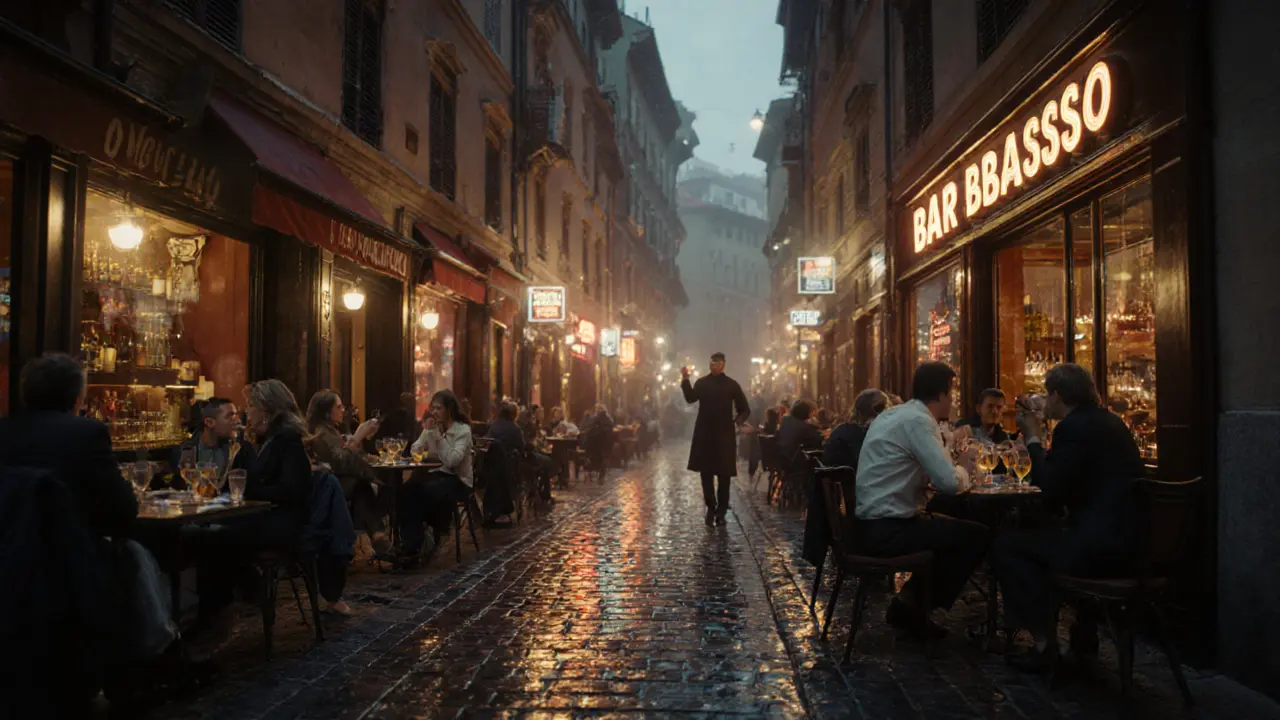11 Nov 2025
- 0 Comments
When the sun sets over Milan’s fashion boutiques and historic facades, the city doesn’t sleep-it switches gears. By 9 p.m., the streets of Brera and Navigli come alive with laughter, clinking glasses, and the low thrum of bass from hidden venues. This isn’t just a city that has nightlife. It’s a city that lives for it. And if you’re looking for more than a tourist trap or a crowded cocktail bar, you need to know where to go-and when.
Where the Locals Go After Work
Forget the glossy brochures. The real Milan nightlife starts where the office workers unwind. Head to Brera, the artsy neighborhood tucked between the Duomo and the Navigli canals. Around 7:30 p.m., you’ll see people in tailored coats and scarves spilling out of tiny enotecas like Enoteca Pinchiorri or Bar Basso. The latter isn’t flashy-it’s a narrow, dimly lit spot famous for inventing the Negroni Sbagliato. Order one. The bitter-sweet fizz of Prosecco replacing gin? It’s the unofficial drink of Milan after hours. Don’t miss Bar Basso’s back room. It’s not marked. You just walk past the barkeep’s nod and down a narrow hallway. No menu. Just ask for "the usual." Locals know what that means.The Navigli District: Canals, Craft Beer, and Late-Night Eats
By 10 p.m., the action shifts to the Navigli canals. Once a working waterway for transporting goods, today it’s lined with outdoor tables, string lights, and live acoustic sets. The vibe is relaxed but electric. You’ll find students from Bocconi University sipping craft beer from La Birreria del Naviglio, while older couples share plates of mortadella and pecorino. This is where you come for the atmosphere, not the name. Skip the places with English menus and big signs. Instead, look for the ones with chalkboards listing daily specials and no prices on the menu. That’s a good sign. At Trattoria da Gianni, they serve handmade gnocchi with sage butter until 2 a.m. on weekends. No reservations. Just show up. If there’s a line, wait. It’s worth it.Clubs That Actually Matter
If you’re after dancing, Milan’s club scene is more selective than Paris and less chaotic than Berlin. The big names like La Scala and Baggio are gone. What’s left are underground spots that don’t advertise. Alcatraz is one of the few that still holds weight. It’s not a club. It’s a converted industrial space near Lambrate. You’ll need to know the night’s theme-techno, house, or experimental electronica-because the crowd changes completely depending on it. Don’t expect velvet ropes or VIP sections. The dress code? Clean jeans, boots, and something that doesn’t scream "tourist." If you show up in a blazer and loafers, you’ll stand out. Not in a good way. Another hidden gem is Le Scimmie in the Porta Venezia area. It’s small, loud, and packed with artists, DJs, and fashion students. The music shifts from 80s Italo-disco to deep house without warning. You won’t find a bottle service menu. But you will find someone handing out free shots of grappa at 1 a.m. because the DJ just dropped a classic.
Where to Drink Before the Club
In Milan, drinking before the club isn’t optional-it’s ritual. Most people start at an aperitivo bar around 7 p.m. and don’t leave until the club opens at midnight. The aperitivo culture here is different from the rest of Italy. You’re not just paying for a drink. You’re paying for a buffet. At Bar Basso, the aperitivo is simple: a Negroni and a few olives. But at Spazio 39 in the Porta Ticinese area, you get a full spread: arancini, mini panzerotti, grilled vegetables, and even risotto balls. It costs €15. That’s less than a pizza in most cities. And you can stay as long as you want. The key? Arrive before 8:30 p.m. After that, the crowd swells and the food runs out.When to Go-and When to Skip
Milan’s nightlife has rhythm. Thursday and Friday are peak nights. Saturday is packed. Sunday? Quiet. But here’s the trick: Tuesday and Wednesday are the secret sweet spots. Locals use these nights to test new bars, meet friends, and avoid the weekend crush. You’ll get better service, shorter lines, and sometimes free entry if you’re lucky. Avoid Friday nights in the Brera district if you hate crowds. The narrow streets turn into a human traffic jam. Stick to the back alleys. Find a quiet courtyard with a single table lit by a lantern. That’s where the real conversations happen.What to Wear (And What Not To)
Milan is fashion-forward. But not in the way you think. You don’t need designer labels. You need polish. Clean shoes. No sneakers unless they’re all-white and spotless. No tank tops. No flip-flops. Even in summer, locals wear light jackets after dark. It’s not about being rich. It’s about being intentional. If you’re unsure, watch the locals. If everyone’s wearing black, wear black. If they’re in linen shirts and loafers, follow suit. The city respects effort. And if you look like you’ve just rolled out of a hotel, you’ll be ignored at the door.
Food After the Club
Most tourists leave after the music stops. But the real experience starts when the clubs close. Around 4 a.m., you’ll find a line outside Trattoria da Vittorio in the Porta Romana area. They serve truffle pasta, fried zucchini flowers, and warm tiramisu until 6 a.m. It’s the only place in the city where the chef still makes the dough by hand every morning. There’s also Antica Trattoria della Pesa, a 100-year-old spot where the owner still writes the menu on a chalkboard each night. Order the ossobuco. It’s slow-cooked for 12 hours. And yes, it’s still open at 5 a.m.How to Get Around
The metro runs until 1:30 a.m. on weekdays and 2:30 a.m. on weekends. After that, you’re on your own. Taxis are expensive and hard to find. Use Bolt or FreeNow-they’re cheaper and faster. Or walk. Milan is walkable at night. The streets are safe, well-lit, and quiet after 2 a.m. Just avoid the areas near the train station after midnight. Stick to the main boulevards: Corso Buenos Aires, Via Torino, Via Dante.Final Tip: Don’t Rush It
Milan’s nightlife isn’t about checking off bars. It’s about the slow build-the aperitivo, the walk to the next spot, the surprise song at 1 a.m., the stranger who becomes a friend over a shared bottle of wine. The best nights don’t end at dawn. They end when you realize you didn’t even check your phone once.Is Milan nightlife safe at night?
Yes, Milan is one of the safest major European cities for nightlife. The streets are well-lit, and police patrols are common in popular areas like Navigli and Brera. Avoid isolated alleys near the train station after midnight, and never leave drinks unattended. Most incidents involve tourists who wander too far off the main routes.
What’s the best night to go out in Milan?
Thursday and Friday are the busiest, but Tuesday and Wednesday offer the best experience. You’ll get better service, shorter lines, and sometimes free entry. Locals use these nights to try new spots without the weekend rush. If you’re looking for authentic vibes, skip Saturday.
Do I need to make reservations for bars or clubs?
For most bars and aperitivo spots, no. Walk-ins are the norm. But for clubs like Alcatraz or Le Scimmie, check their Instagram or website. Some nights have ticketed events, especially for guest DJs. If you see "entrata con prenotazione," you’ll need to book ahead. Otherwise, just show up.
How much should I budget for a night out in Milan?
You can have a full night out for €40-€60. That includes an aperitivo (€15-€20), a couple of drinks at a club (€8-€12 each), and a late-night bite. Taxis or rideshares add another €10-€15. Skip the tourist traps in the city center-prices there are inflated. Stick to Brera, Navigli, and Lambrate for real value.
Are there any dress codes I should know about?
Yes. Milan has a quiet dress code. No sportswear, no flip-flops, no ripped jeans. Clean, minimalist clothing works best. Men: dark jeans, button-down shirt, loafers. Women: tailored pants or a simple dress, ankle boots. You don’t need designer brands-just look put together. If you’re unsure, copy what the locals are wearing.
